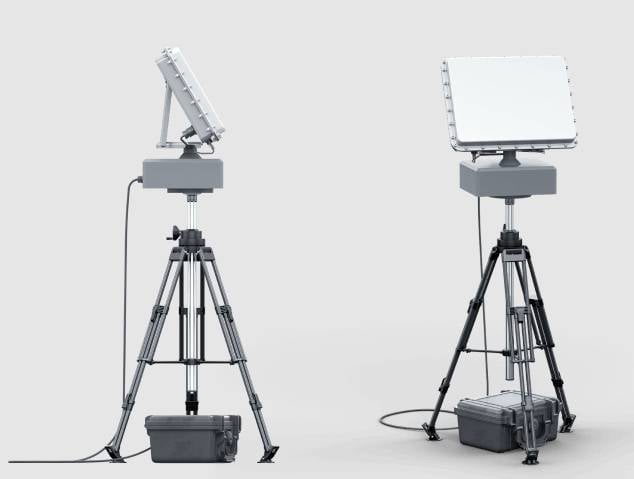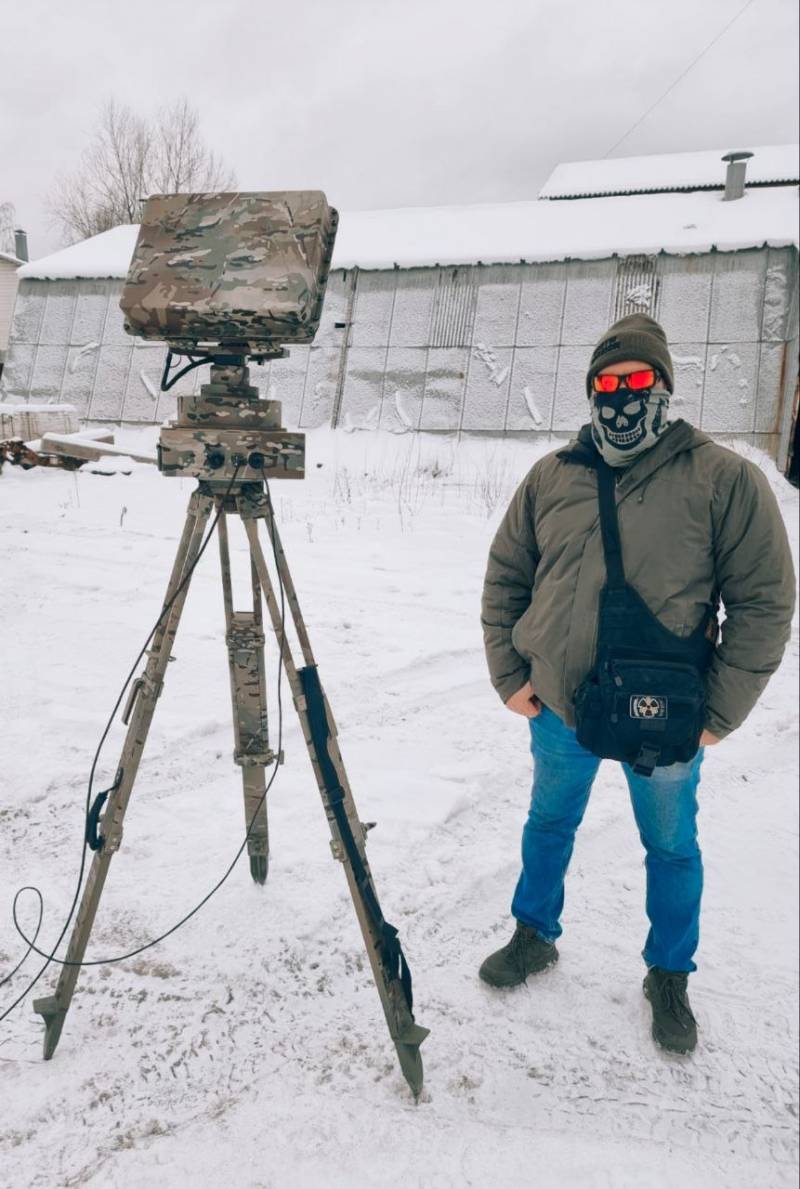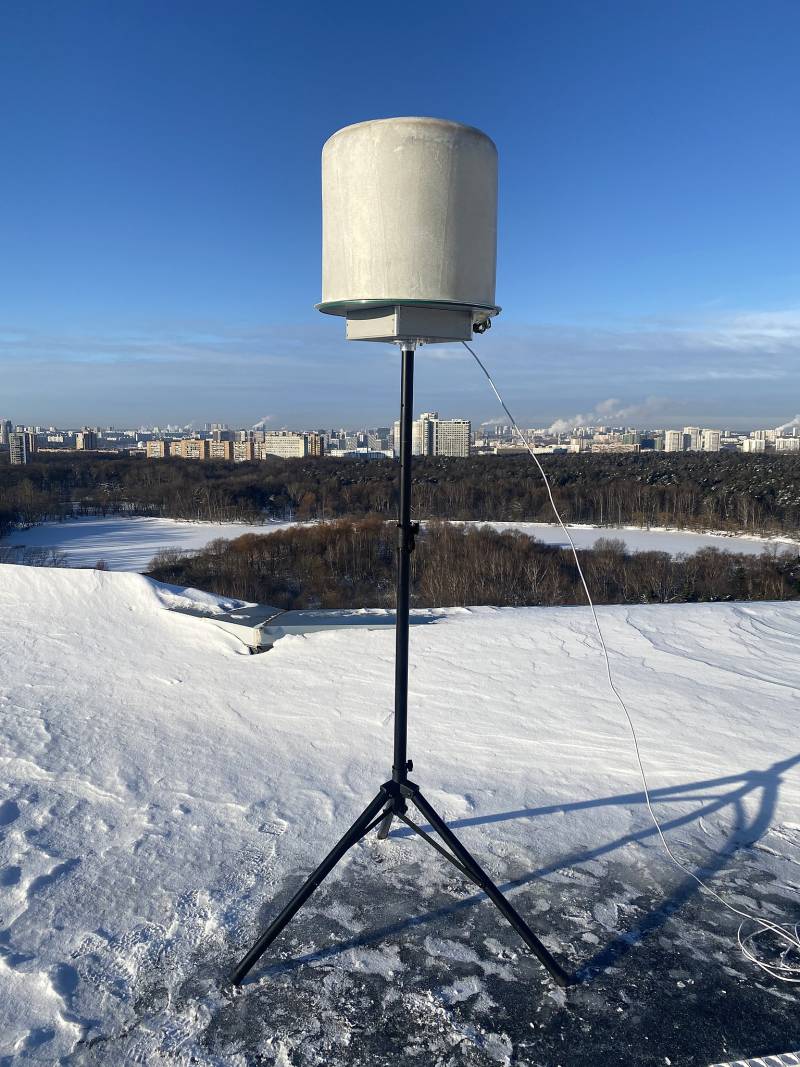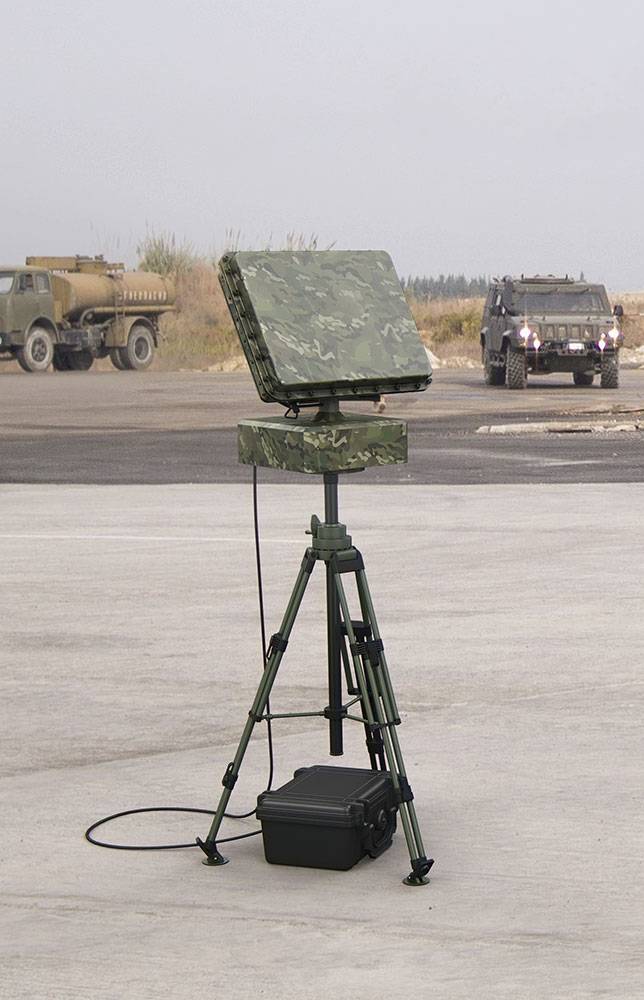Wearable radar "burdock" is being tested in the zone of the special operation

General view of the product "burdock", the operator's console is not shown. "SOZ" graphics
In recent months, a mass of various equipment and equipment has appeared in the troops, designed to combat enemy unmanned aerial vehicles. One of the novelties of this kind is the wearable radar station Burdock. Recently it became known that several similar products are being tested in the area of the Special Operation and show their real characteristics and capabilities.
New developments
Last year, the young Moscow company "Basic Technologies" presented a promising small radar station (MRLS) "Volna", and in several versions at once. It is intended to cover the air situation and search for complex air targets with low RCS - such as small and ultra-small UAVs. According to the target designation of such a station, fire or radio equipment should work, which are responsible for the defeat or suppression of the found object.
In the spring of 2022, it became known that the Volna radar had reached small-scale production and was already of interest to customers. Unnamed organizations wished to purchase such equipment and deploy it at their facilities to protect against intruders.
Also this year, employees of Basic Technologies joined the workforce of the Mytishchi enterprise Sestroretsky weapons plant". At the new place of work, they finalized one of the variants of the Volna MRLS and created a portable station (NRS) with the cipher Burdock on its basis.
To date, the development of the Burdock project has been completed, and POPs have manufactured a number of experimental or pre-production products. Not so long ago, testing of stations in different conditions began. In recent weeks, there have been some interesting reports in this regard.

"burdock" on trials. Photo Telegram / RSOTM
In the Special Operations Zone
At the end of November, the well-known telegram channel Reverse Side Of The Medal announced the testing of the new Burdock product. One of the authors of the channel took part in such events. At the same time, it was not reported what kind of checks were carried out, with what result they passed, etc. The short message was accompanied by a photo of the new NRS in the deployed state and the author of RSOTM.
On December 13, the same channel revealed new interesting data. It is reported that the SOZ not only manufactured a certain number of Burdocks, but also handed them over to the formations involved in the Special Operation. With the help of such equipment, they are already monitoring the sky in two sectors of the front. Continued deliveries are expected with clear beneficial consequences.
It is reported that the manufacturer maintains contact with the operators and takes into account their experience. In particular, a unified knowledge base is being created for the preparation of NRS calculations. With its help, different departments will be able to exchange experience in the use of technology to achieve maximum results, regardless of the conditions. The design of the stations is also being gradually improved.
Thus, our members of the Special Operation have at their disposal a new useful technical tool that allows us to reduce the threat from enemy UAVs. So far, Burdock navigation radars are not distinguished by large numbers, but they are already coping with the tasks set. Obviously, in the future their number will increase - with understandable positive consequences.
Technical features
The developer organization reports that when creating the Burdock radar, modern element base and new circuit solutions were used. Due to this, it was possible to increase performance and efficiency, as well as to reduce the dimensions of the product and reduce its energy consumption.

The basic version of the radar "Volna". Photo by Wikimedia Commons
The Burdock product is positioned as a wearable radar. For carrying by calculation or transportation by any transport, the station is divided into several components, the total mass of which is only 25,5 kg. The complex includes the actual station with an antenna device, a tripod, a power source and an operator console. Assembly and preparation for work on the position require no more than 5 minutes.
A rectangular box-shaped body with a rotating AFAR is mounted on a tripod. Provides circular scanning in azimuth with an elevation angle of up to 20 ° in the absence of dead zones. Depending on the assigned tasks, the station can monitor both the airspace and the surface of the earth. In both cases, detection of stationary and moving objects is provided.
The station operates in the range of 9,2-9,5 GHz, which allows it to be operated without special permits. The antenna produces a narrow beam that provides the necessary characteristics, but makes it difficult to detect. The ability of the radar to find objects with EPR up to 0,01 sq.m. The detection range of ultra-small air targets reaches 10 km, the height is 5 km. The speed of the object is up to 150 km/h. Automation accompanies up to 256 objects.
The station is controlled by a computer with the necessary software. If necessary, such a remote control can be placed at a great distance from the antenna post. The software part of the radar is compatible with different operating systems and is easy to use. The operator receives information in a graphical form and can use topographic maps for greater convenience.
Burdock detects ground and air targets and provides data on their location. The information is updated every 1,25 sec. Data on the situation and targets can be transmitted to command posts and other consumers, incl. fire or radio systems. With the help of their regular means, the latter must suppress or hit the targets found.

MRLS "Volna", version "21" - probably the basis for the new Burdock. Photo by Wikimedia Commons
The possibility of combining several radars into a network for joint operation under the control of one operator is being studied. In this case, the required number of Burdocks will be able to monitor a larger area, incl. with partial overlap of areas of responsibility. There will also be new opportunities in terms of processing and issuing data.
The radar includes its own power supply that provides continuous operation for 8 hours. It also provides for operation from 220 V networks or from 12-volt automotive systems.
Strengthen defense
Thus, in the shortest possible time, the Russian industry was able to develop and bring to production a promising wearable radar. In this case, we are talking about a specialized system capable of solving complex problems. The Burdock product, like the previous Volna radar, is intended primarily for detecting and tracking small-sized complex targets.
The base "Wave" had previously been tested and, as far as is known, lived up to expectations. Now at the stage of testing and fine-tuning is created on its basis "Burdock". Stations of this type are already being tested in the combat zone and work not on training targets, but on real enemy UAVs. Apparently, the change in working conditions in general did not affect the characteristics and efficiency.
It should be noted that Volna and Burdock are not the only radars of their kind. Other stations with similar characteristics and similar capabilities exist and are being developed. Now a variety of radio systems designed to combat enemy UAVs are being tested in practice and, probably, compared with each other.
It can be expected that during the current Special Operation, our army will accumulate the necessary experience in the use of such systems, draw conclusions, and also select the most successful samples. They will be able to be widely used and will give the army the necessary defense capabilities. Whether it will be Burdock or another system of this class, time will tell.
Information